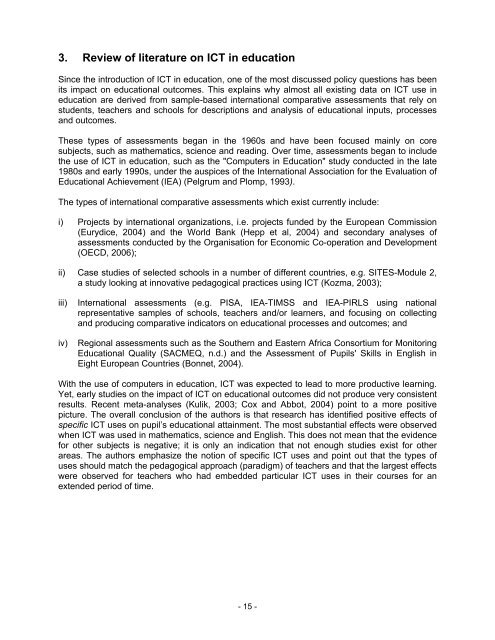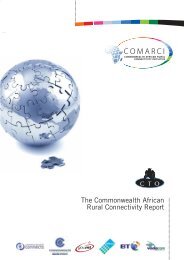Guide to measuring information and ... - unesdoc - Unesco
Guide to measuring information and ... - unesdoc - Unesco
Guide to measuring information and ... - unesdoc - Unesco
You also want an ePaper? Increase the reach of your titles
YUMPU automatically turns print PDFs into web optimized ePapers that Google loves.
3. Review of literature on ICT in education<br />
Since the introduction of ICT in education, one of the most discussed policy questions has been<br />
its impact on educational outcomes. This explains why almost all existing data on ICT use in<br />
education are derived from sample-based international comparative assessments that rely on<br />
students, teachers <strong>and</strong> schools for descriptions <strong>and</strong> analysis of educational inputs, processes<br />
<strong>and</strong> outcomes.<br />
These types of assessments began in the 1960s <strong>and</strong> have been focused mainly on core<br />
subjects, such as mathematics, science <strong>and</strong> reading. Over time, assessments began <strong>to</strong> include<br />
the use of ICT in education, such as the "Computers in Education" study conducted in the late<br />
1980s <strong>and</strong> early 1990s, under the auspices of the International Association for the Evaluation of<br />
Educational Achievement (IEA) (Pelgrum <strong>and</strong> Plomp, 1993).<br />
The types of international comparative assessments which exist currently include:<br />
i) Projects by international organizations, i.e. projects funded by the European Commission<br />
(Eurydice, 2004) <strong>and</strong> the World Bank (Hepp et al, 2004) <strong>and</strong> secondary analyses of<br />
assessments conducted by the Organisation for Economic Co-operation <strong>and</strong> Development<br />
(OECD, 2006);<br />
ii) Case studies of selected schools in a number of different countries, e.g. SITES-Module 2,<br />
a study looking at innovative pedagogical practices using ICT (Kozma, 2003);<br />
iii) International assessments (e.g. PISA, IEA-TIMSS <strong>and</strong> IEA-PIRLS using national<br />
representative samples of schools, teachers <strong>and</strong>/or learners, <strong>and</strong> focusing on collecting<br />
<strong>and</strong> producing comparative indica<strong>to</strong>rs on educational processes <strong>and</strong> outcomes; <strong>and</strong><br />
iv) Regional assessments such as the Southern <strong>and</strong> Eastern Africa Consortium for Moni<strong>to</strong>ring<br />
Educational Quality (SACMEQ, n.d.) <strong>and</strong> the Assessment of Pupils' Skills in English in<br />
Eight European Countries (Bonnet, 2004).<br />
With the use of computers in education, ICT was expected <strong>to</strong> lead <strong>to</strong> more productive learning.<br />
Yet, early studies on the impact of ICT on educational outcomes did not produce very consistent<br />
results. Recent meta-analyses (Kulik, 2003; Cox <strong>and</strong> Abbot, 2004) point <strong>to</strong> a more positive<br />
picture. The overall conclusion of the authors is that research has identified positive effects of<br />
specific ICT uses on pupil’s educational attainment. The most substantial effects were observed<br />
when ICT was used in mathematics, science <strong>and</strong> English. This does not mean that the evidence<br />
for other subjects is negative; it is only an indication that not enough studies exist for other<br />
areas. The authors emphasize the notion of specific ICT uses <strong>and</strong> point out that the types of<br />
uses should match the pedagogical approach (paradigm) of teachers <strong>and</strong> that the largest effects<br />
were observed for teachers who had embedded particular ICT uses in their courses for an<br />
extended period of time.<br />
- 15 -
















